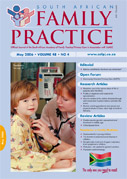Morphine use in the last six days of life of patients with HIV/AIDS at the inpatient unit of a South African hospice implementing the ICHC model
Abstract
Background Seventy-five per cent of the world’s HIV/AIDS population resides in Sub-Saharan Africa. South Africa, along with the rest of Sub-Saharan Africa, is experiencing an increasing disease and palliative care burden as a result of the HIV/AIDS pandemic. At present there is no cure for AIDS and access to antiretroviral treatment is limited. HIV/AIDS is the largest single cause of death in South Africa, accounting for 30% of deaths in 2000. An estimated 20 000 of the approximately 5 350 000 infected South Africans receive antiretroviral treatment. To cope with the rising need for AIDS-related health services, a comprehensive, integrated approach to health care is advocated, with a shift in focus from hospital care to home-based care. The Department of Health supports a community home-based care (ICHC) model as one of five models of care. It is based on similar principles to palliative care and was piloted at seven hospices in South Africa. This study was conducted in the inpatient unit (IPU) of a hospice participating in the ICHC pilot project. This model requires that the hospice provide the overall management of the home-based care programme, as well as various forms of support. Care provision is shared between professional nurses and non-professional community-based caregivers, who are trained by Hospice. For challenging symptoms, respite or terminal care, the hospice has a six-bed IPU to which patients can be admitted for short periods. The AIDS patients admitted to the IPU of the study hospice were all cared for under the ICHC model. Method This study was a retrospective case-control study conducted in a hospice in South Africa. Cases were consecutive deaths related to AIDS. Controls were cancer patients matched for socioeconomic status. Results Five days before their death, morphine for pain control was given to three of the 29 (10%) AIDS patients and to 20 of 29 (69%) cancer patients (p < 0.001). On the day of their death, morphine for pain control was given to 17 (59%) of the AIDS patients and 25 (86%) of the cancer patients (p < 0.05). Eleven (65%) of the 17 AIDS patients who were given morphine died within 48 hours of commencing with the treatment. The morphine starting dosages were within the lower therapeutic range. Conclusions The palliative care of dying cancer patients met internationally recognised standards. The results suggest that the pain of AIDS patients admitted to the IPU was under treated in terms of both dosage and duration. It is unlikely that the use of opiates or sedatives hastened death in dying AIDS (or cancer) patients. All the AIDS patients admitted to the IPU were cared for under the integrated community home-based care (ICHC) model. This raises the following questions: Is the ICHC model as implemented by this hospice achieving the symptom relief intended? And, is this typical of palliative care for AIDS patients in South Africa? (SA Fam Pract 2006;48(4): 14)
Issue
Section
Original Research
By submitting manuscripts to SAFP, authors of original articles are assigning copyright to the South African Academy of Family Physicians. Copyright of review articles are assigned to the Publisher, Medpharm Publications (Pty) Ltd, unless otherwise specified. Authors may use their own work after publication without written permission, provided they acknowledge the original source. Individuals and academic institutions may freely copy and distribute articles published in SAFP for educational and research purposes without obtaining permission.

